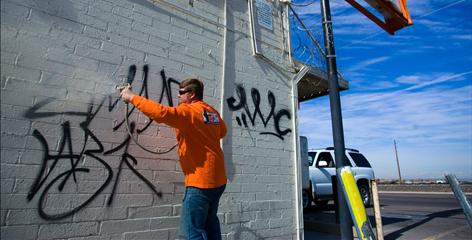
The latest weapon comes in the form of an iPhone application, developed by a Los Angeles company, that will allow cities to catalog graffiti, dispatch cleanup crews and provide key evidence to police.
The software application lets citizens or government officials photograph graffiti with an iPhone and send the image to the company's databases. The location of the graffiti is automatically marked using the phone's GPS capabilities. An electronic work order is created and, in minutes, a technician is sent with matching paint to cover up the graffiti. The images are catalogued and mapped so police can track down suspects and build a stronger case.
In Tucson, for example, Lt. Ron Stiso said iPhone data were used to track down 28-year-old Bobby Leverette, arrested Feb. 4 on suspicion of more than 20 felony counts of criminal damage, plus narcotics violations.
"We've made multiple arrests," Stiso said. "It certainly is a great tool for us."
Graffiti eradication is big business. Nationwide, the cost is estimated at $15 billion to $18 billion a year to monitor, detect, remove and repair graffiti damage, said Randy Campbell, a retired California Highway Patrol officer and president of the NoGraf Network, a national consortium of police agencies dedicated to ending the vandalism.
Campbell said there is other technology being used to fight the problem, including:
- GRIP Systems, an $850-a-year subscription program for cities, allows residents to send in photos of graffiti from cellphones, or use their computers to e-mail photos and the location of the graffiti, which get logged into a database. The website maps other crimes as well using GPS and Google Maps.
- Tripline Systems uses covert motion-detecting cameras that are hidden in bushes or pipes. When camera sensors are tripped, it sends a picture of the vandal committing the crime to a police officer's BlackBerry.
- Paint-resistant coatings and even alarms with high-frequency sounds are aimed at youth to keep offenders away from popular graffiti sites. Cities have used these tools with varying degrees of success, Campbell said.
"It helps police and it helps the citizens - a win-win both ways," Steinhart said.
Next month, in Avondale, Arizona, residents will be invited to download the software so they can help combat graffiti.
Avondale struggled for years to keep up with graffiti, said Gina Montes, director of Avondale's Neighborhood and Family Services Department. The city has a $110,000 annual contract with Graffiti Protective Coatings. Steinhart said his company's service costs on average $20 per graffiti call, roughly the same as a gallon of paint.
In Long Beach, where officials have just begun experimenting with the iPhone system, Assistant City Manager Suzanne Frick said they eventually will allow citizens to report code violations, potholes and other problems along with graffiti.
"We're only testing so far," Frick added, "but what we're looking at right now is fantastic."
Mesa, Arizona, neighborhood activist Stephanie Wright said residents deserve better than a bare-bones response to graffiti. Mesa, one of the cities considering a contract with Graffiti Protective Coatings, typically has two employees a day roaming the city using recycled paint to cover graffiti with gray squares.
"They do the best they can, but the system isn't working," Wright said.
Craig Blum, a Mesa field-operations supervisor, said inspectors respond to 4,000 to 5,000 graffiti complaints a year. The city uses Eagle Scouts and probationers performing community service to help paint over graffiti within 24 hours of getting a report.
"(Graffiti) impacts how people feel about the way they live," said Montes, in Avondale. "They feel insecure. It makes people feel unsafe, that they've been violated."
Walsh and Wagner report for The Arizona Republic



Reader Comments
to our Newsletter